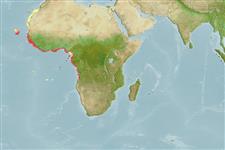Common names from other countries
Environment: milieu / climate zone / depth range / distribution range
Ecologia
marinhas demersal; intervalo de profundidade 20 - 300 m (Ref. 127989). Tropical; 33°N - 13°S, 27°W - 15°E (Ref. 5222)
Eastern Atlantic: Western Sahara to Angola, including Cape Verde and the Sao Tome and Principe islands. Also recorded from the Mediterranean.
Length at first maturity / Tamanho / Peso / Idade
Maturity: Lm 18.0 range ? - ? cm
Max length : 70.0 cm TL macho/indeterminado; (Ref. 27000); common length : 40.0 cm TL macho/indeterminado; (Ref. 26999)
Espinhos dorsais (total): 9; Raios dorsais moles (total): 15-16; Espinhos anais 3; Raios anais moles: 9 - 10. Distinguished by the following characteristics: body depth less than head length, 2.8-3.2 in SL; head length 2.7-3.0 in SL; interorbital area convex; rounded preopercle, finely serrate, with shallow notch, fleshy lower edge; subopercle and interopercle with few small serrae covered by skin; maxilla reaching vertical at rear edge of eye or beyond; pectoral fins longer than pelvic fins, pectoral fin length contained 1.5-1.7 in HL; pelvic fins reaching or nearly reaching anus; caudal fin rounded; lateral-body scales ctenoid, without auxiliary scales (Ref. 089707).
Found on sandy and rocky bottoms (Refs. 32181, 127989). Diandric protogynous hermaphrodite (Ref. 089707).
Life cycle and mating behavior
Maturidade | Reprodução | Desova | Ovos | Fecundidade | Larvas
Pelagic spawner (Ref. 32181). Low ratio of males in population correlated with polygamy (Ref. 32181). This study (Ref. 32181), concluded that some males of C. taeniops may not pass through a functional female stage as observed in most groupers, and that these males may have developed directly from immature females conferring with the hypothesis of Shapiro (1987). Diandric (Ref. 103751).
Heemstra, P.C. and J.E. Randall, 1993. FAO Species Catalogue. Vol. 16. Groupers of the world (family Serranidae, subfamily Epinephelinae). An annotated and illustrated catalogue of the grouper, rockcod, hind, coral grouper and lyretail species known to date. Rome: FAO. FAO Fish. Synop. 125(16):382 p. (Ref. 5222)
Categoria na Lista Vermelha da IUCN (Ref. 130435)
CITES (Ref. 128078)
Not Evaluated
Ameaça para o homem
Harmless
Utilização humana
Pescarias: pouco comercial
Mais informação
ReferênciasAquaculturaPerfil para aquaculturaEstirpesGenéticaElectrophoresesHereditariedadeDoençasProcessamentoMass conversion
Ferramentas
Relatórios especiais
Descarregue XML
Fontes da internet
Estimates based on models
Preferred temperature (Ref.
115969): 15.8 - 20.7, mean 19.2 (based on 47 cells).
Phylogenetic diversity index (Ref.
82804): PD
50 = 0.5000 [Uniqueness, from 0.5 = low to 2.0 = high].
Bayesian length-weight: a=0.00977 (0.00645 - 0.01482), b=3.10 (2.98 - 3.22), in cm Total Length, based on LWR estimates for this species & Genus-body shape (Ref.
93245).
Nível Trófico (Ref.
69278): 4.5 ±0.80 se; based on food items.
Resiliência (Ref.
120179): Baixo, tempo mínimo de duplicação da população 4,5 - 14 anos (Preliminary K or Fecundity.).
Fishing Vulnerability (Ref.
59153): High vulnerability (56 of 100).
